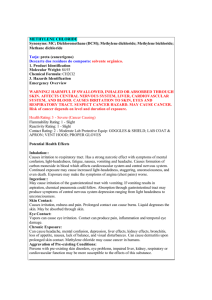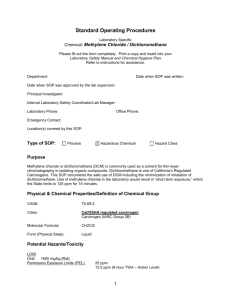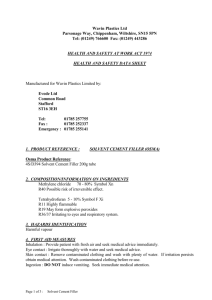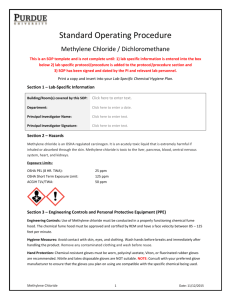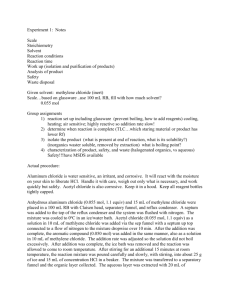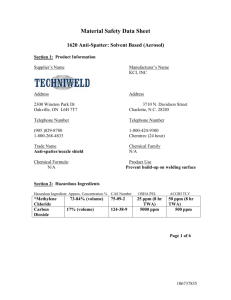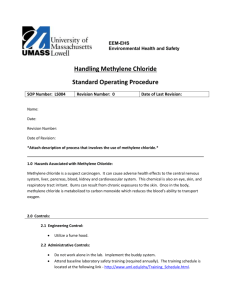Safety Data Sheet - Megaloid Laboratories
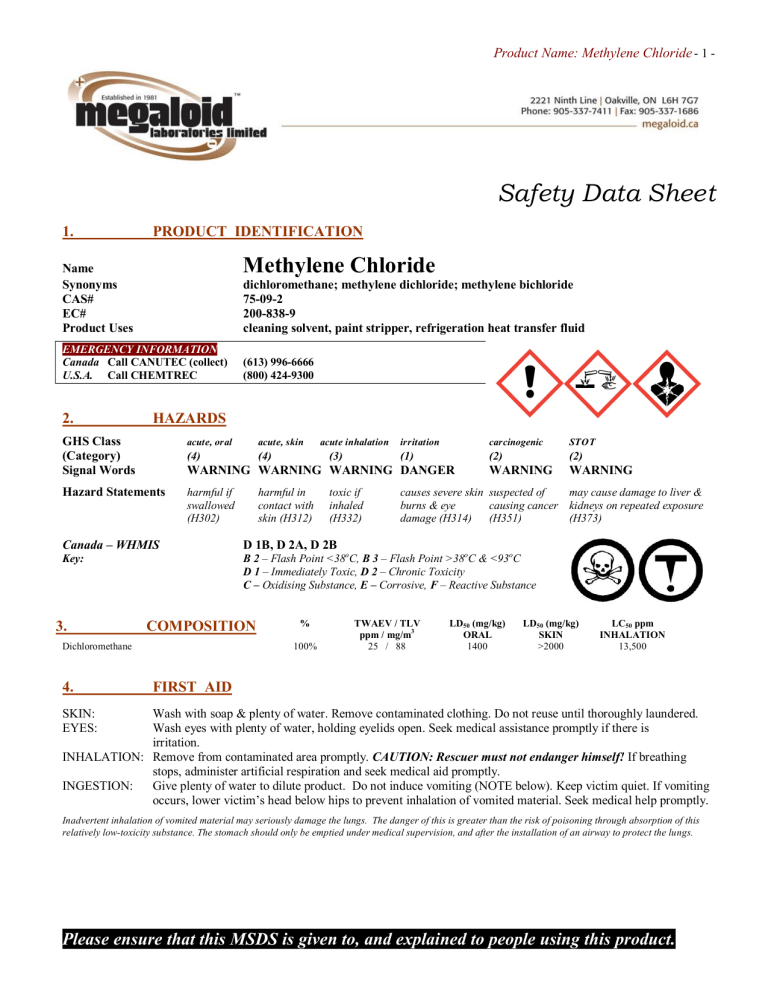
Product Name: Methylene Chloride 1
Safety Data Sheet
1. PRODUCT IDENTIFICATION
Name
Synonyms
CAS#
EC#
Product Uses
Methylene Chloride
dichloromethane; methylene dichloride; methylene bichloride
75092
2008389 cleaning solvent, paint stripper, refrigeration heat transfer fluid
EMERGENCY INFORMATION
Canada Call CANUTEC (collect) (613) 9966666
U.S.A.
Call CHEMTREC (800) 4249300
2. HAZARDS
GHS Class
(Category)
Signal Words acute, oral
(4) acute, skin acute inhalation irritation
(4) (3) (1)
WARNING WARNING WARNING DANGER
Hazard Statements harmful if harmful in toxic if swallowed contact with inhaled
(H302) skin (H312) (H332) carcinogenic
(2)
STOT
(2)
WARNING WARNING causes severe skin suspected of burns & eye may cause damage to liver & causing cancer kidneys on repeated exposure damage (H314) (H351) (H373)
Canada – WHMIS
Key:
D 1B, D 2A, D 2B
B 2 – Flash Point <38 o
C, B 3 – Flash Point >38 o
C & <93 o
C
D 1 – Immediately Toxic, D 2 – Chronic Toxicity
C – Oxidising Substance, E – Corrosive, F – Reactive Substance
3. COMPOSITION
Dichloromethane
%
100%
TWAEV / TLV ppm / mg/m
25 / 88
LD
50
(mg/kg)
ORAL
1400
LD
50
(mg/kg)
SKIN
>2000
LC
50 ppm
INHALATION
13,500
4. FIRST AID
SKIN:
EYES:
Wash with soap & plenty of water. Remove contaminated clothing. Do not reuse until thoroughly laundered.
Wash eyes with plenty of water, holding eyelids open. Seek medical assistance promptly if there is irritation.
INHALATION: Remove from contaminated area promptly.
CAUTION: Rescuer must not endanger himself!
If breathing stops, administer artificial respiration and seek medical aid promptly.
INGESTION: Give plenty of water to dilute product. Do not induce vomiting (NOTE below). Keep victim quiet. If vomiting occurs, lower victim’s head below hips to prevent inhalation of vomited material. Seek medical help promptly.
Inadvertent inhalation of vomited material may seriously damage the lungs. The danger of this is greater than the risk of poisoning through absorption of this relatively lowtoxicity substance. The stomach should only be emptied under medical supervision, and after the installation of an airway to protect the lungs.
Please ensure that this MSDS is given to, and explained to people using this product.
Product Name: Methylene Chloride 2
5. FIRE FIGHTING & FLAMMABILITY
Flash Point
Autoignition Temperature
Flammable Limits
Combustion Products
Firefighting Precautions
Static Charge Accumulation will not flash – burns in fire above 102 o
C / 214 o
F; cannot sustain combustion on its own
556 o
C / 1033 o
F; also 640 o
C / 1184 o
F
12% – 19% – very narrow limit carbon monoxide, smoke, phosgene ( highly toxic ) plus hydrogen chloride & chlorine foam, dry chemical, water fog, water spray; firefighters must wear SCBA not applicable – low flammability
6. ACCIDENTAL RELEASE MEASURES
Leak Precaution dyke to control spillage and prevent environmental contamination
Handling Spill ventilate contaminated area; recover free liquid with suitable pumps; absorb residue on an inert sorbent, sweep, shovel & store in closed containers for recycling or disposal; workers involved in spill cleanup must wear respirators with organic vapour cartridge; use a fresh cartridge every time
7. HANDLING & STORAGE
Do not store in direct sunlight – drums may overheat and burst ! Store below 30 o
C / 85 o
F, away from substances named in Part 10. Always ensure that containers, whether empty or full, are tightly sealed unless in use.
Warning – this product has a low boiling point.
Before opening drums check that the drum head is not bulging outwards. When opening, loosen bung slowly, releasing any pressure which may have developed inside the drum.
Avoid breathing product vapour. Use with adequate ventilation. If dealing with a spill, ventilate area well, wear a suitable respirator (see Part 8). Wear an airsupplied respirator if temperature exceeds 30 o
C, or if good ventilation cannot be assured.
This product should only be used in a closed apparatus or with very effective exhaust ventilation.
Never cut, drill, weld or grind on or near this container. Avoid all contact with skin & wash work clothes frequently. An eye bath & safety shower must be available near the workplace.
The odour threshold is higher than the exposure limit . Routine wearing of a respirator is hazardous; when the wearer detects methylene chloride, the exposure limit has been exceeded! Only wear a respirator for emergencies (eg: spill cleanup; always attach a fresh absorber cartridge every time.
8. EXPOSURE CONTROL & PERSONAL PROTECTION
Ontario TWAEV 50ppm / 175mg/m
3
ACGIH TLV
OSHA PEL
Ventilation
50ppm / 174mg/m
25ppm / 88mg/m
3
3
Ontario STEV
ACGIH CEV
not listed not listed
125ppm / 435mg/m
3
OSHA STEL mechanical ventilation is required to control airborne titre to regulated limits; respirators with organic
Hands vapour cartridges should be available for all workers in the area should ventilation or vapour containment fail ( store respirators in airtight (“Ziplock” or “Tupperware”) to maintain “freshness” ) polyvinyl alcohol, “Trellchem HPS”, or “Tychem” gloves offer 8hr resistance – other types also protect;
Eyes
Clothing consult supplier for suitability safety glasses with side shields or chemical goggles – always protect the eyes wear impermeable (above) apron, boots, & long sleeves if there is any danger of splashing,
Please ensure that this MSDS is given to, and explained to people using this product.
Product Name: Methylene Chloride 3
9. PHYSICAL PROPERTIES
Odour & Appearance
Odour Threshold clear, colourless liquid with mild, pleasant (but sharp) odour
150ppm – very variable
NOTE: Pleasant odour increases hazard, as does the fact that the odour threshold is 3 times the exposure limit!
Vapour Pressure 349mmHg / 46.5kPa (20 o
C / 68 o
F)
Evaporation Rate ( Butyl Acetate = 1 ) 14.5 – very rapid!
Vapour Density (air = 1)
Boiling Range
Freezing Point
Specific Gravity
Water Solubility
3
40 o
C / 104 o
97 o
F
C / 143 o
F
1.329 (20/20 o
C)
13grams/litre (20 o
C / 68 o
F)
Also soluble in most organic solvents
Log P o/w
( Octanol/H
2
O partition ) 1.25 (Bioconcentration Factor = 2)
Viscosity 0.4 centipoise (20 o
C / 68 o
F) pH
Conversion Factor
Molecular Weight none – ( does not liberate hydrogen ions when dissolved
1ppm = 3.48mg/m
85grams per mole
3
)
10. REACTIVITY
Dangerously Reactive With
Also Reactive With
Stability
Decomposes in Presence of strong oxidizers may cause explosion; reacts with amines releasing heat; forms explosive substances with alkali metals (Na, K, Li) & N
2
O
4 or N
2
O
5
& nitric acid flammable in air in the presence of >0.5% methanol; corrodes some metals at elevated temperature in the presence of moisture; attacks many plastics, epoxies & elastomers stable; will not polymerize water – decomposes gradually to form hydrochloric acid
Decomposition Products phosgene and hydrogen chloride form in fire
Sensitive to Mechanical Impact no
11. TOXICITY
Effects, Acute Exposure
Skin Contact
Skin Absorption
Eye Contact
Inhalation
Ingestion severely irritating – rapid evaporation may prevent this ; >5min contact ( eg: prolonged contact caused by material trapped between gloves & skin ) may cause chemical burns slight; no toxic effects likely by this route irritating; vapour irritating at 500ppm; temporary eye damage has been reported
200ppm caused dizziness & nausea, plus impaired coordination; irritating above 500ppm; headache, dizziness, drowsiness, intoxication, nausea, etc may occur; high concentrations cause pulmonary oedema & eventual death; High vapour pressure increases risk of injury from inhalation irritation of mouth and throat, possibly leading to swelling – not a route of industrial exposure
Effects, Chronic Exposure
General prolonged exposure may cause dermatitis; prolonged inhalation (500100ppm) has caused some neurological problems: balance, speech, vision, confusion; metabolism of dichloromethane creates carbon monoxide, possibly responsible for some of above
Sensitising not a sensitiser in humans or animals
Carcinogen/Tumorigen considered an animal carcinogen (ACGIH); possible human carcinogen (IARC & NTP)
Reproductive Effect
Mutagen fetotoxic in rodents only in presence of maternal toxicity; testicular atrophy in rats; reduced sperm count in men working with dichloromethane; dichloromethane found in breast milk of women working with the product mutagen in rodents and human cell culture; no evidence of mutagenic or teratogenic activity resulting from industrial exposure
Synergistic With
LD
50
(oral)
LD
50
(skin)
LC
50
(inhalation) not known
2280mg/kg (♂rat), 1400mg/kg (♀rat)
>2000mg/kg (rabbit)
13,50019,800ppm (rat), 17,36520,375ppm (mouse), 14,205ppm (guinea pig)
Please ensure that this MSDS is given to, and explained to people using this product.
Product Name: Methylene Chloride 4
12. ECOLOGICAL INFORMATION
Bioaccumulation
Biodegradation methylene chloride is metabolised or otherwise eliminated and cannot bioaccumulate biodegrades readily & rapidly in the presence of oxygen; complete biodegradation reported to take
Abiotic Degradation less than a week; anaerobic biodegradation with ½life of 11 days methylene chloride reacts with atmospheric NOx – reported rates highly variable
Mobility in soil, water sufficiently water soluble to move readily in soil & water; adsorbs strongly to peat; rapid evaporation may limit movement
Aquatic Toxicity
LC
50
(Fish, 96hr) 193 & 220mg/l (Lepomis macrochirus), 177, 193, 310, 330 & 502mg/litre (Pimephelas promelas),
330mg/litre (Cyprinodon variegatus) & others
LC
50
(Crustacea 48hr) 135, 190, 270 & 1682mg/l (Daphnia magna), 108mg/litre (Palaemonetes pugio)
EC
50
(Algae) 2300mg/litre (Chlorella vulgaris), >660mg/litre (Selenastrum capricornutum & Skeletonema costatum)
EC
50
(Bacteria) 2.9mg/litre (Photobacterium phosphoreum)
13. DISPOSAL
Waste Disposal do not flush to sewer , recycle solvent if possible, may be incinerated in approved facility with flue gas monitoring & scrubbing
Containers Drums should be reused. Recondition and pressure test by a licensed reconditioner prior to reuse.
Pails must be vented and thoroughly dried prior to crushing and recycling.
IBCs (intermediate bulk containers): polyethylene bottle must be pressure tested & recertified at 30 months.
Replace at 60 months (5yrs). Steel containers must be inspected, pressure tested & recertified every 5 years.
Never cut, drill, weld or grind on or near this container, even if empty
14. TRANSPORT CLASSIFICATION
Canada TDG
AND
U.S.A. 49 CFR
Marine Pollutant
ERAP
PIN
Shipping Name
Class
Packing Group
UN1593 dichloromethane
6.1
III not a marine pollutant not required
15.
Canada DSL
U.S.A. TSCA
Europe EINECS
REGULATIONS
on inventory on inventory on inventory
U.S.A. Regulations:
Immediately Dangerous to Life or Health: NIOSH recommends that methylene chloride be regulated as an occupational carcinogen.
Allowable Tolerances: Dichloromethane is exempted from the requirement of a tolerance when used as a solvent or cosolvent in accordance with good agricultural practice as inert (or occasionally active) ingredients in pesticide formulations applied to growing crops only.
OSHA Standards: The employer shall ensure that no employee is exposed to an airborne concentration of methylene chloride in excess of 25 ppm as an 8 hr TWA. The employer shall ensure that no employee is exposed to an airborne concentration of methylene chloride in excess of 125 ppm as determined over a sampling period of 15 minutes.
NIOSH Recommendations: NIOSH recommends that methylene chloride be regulated as an occupational carcinogen. NIOSH usually recommends that occupational exposures to carcinogens be limited to the lowest feasible concn.
Threshold Limit Values: 8 hr Time Weighted Avg (TWA): 50 ppm Excursion Limit Recommendation: Excursions in worker exposure levels may exceed 3 times the TLVTWA for no more than a total of 30 minutes during a work day, and under no circumstances should they exceed 5 times the TLVTWA, provided that the TLVTWA is not exceeded. A3; Confirmed animal carcinogen with unknown relevance to humans. Biological Exposure Index (BEI): Determinant: Dichloromethane in urine; Sampling Time: end of shift; BEI: 0.3 mg/L. The biological determinant is an indicator of exposure to the chemical, but the quantitative interpretation of the measurement is ambiguous. These determinants should be used as a screening test if a quantitative test is not practical, or as a confirmatory test if the quantitative test is not specific and the origin of the determinant is in question.
Atmospheric Standards: This action promulgates standards of performance for equipment leaks of Volatile Organic Compounds (VOC) in the Synthetic Organic Chemical Manufacturing Industry (SOCMI). The intended effect of these standards is to require all newly constructed, modified, and reconstructed SOCMI process units to use the best demonstrated system of continuous emission reduction for equipment leaks of
VOC, considering costs, non air quality health and environmental impact and energy requirements. Methylene chloride is produced, as an intermediate or a final product, by process units covered under this subpart.
Methylene chloride has been designated as a hazardous air pollutant under section 112 of the Clean Air Act.
Please ensure that this MSDS is given to, and explained to people using this product.
Product Name: Methylene Chloride 5
15. REGULATIONS, cont’d
Federal Drinking Water Standards: EPA 5 ug/l
State Drinking Water Standards: New Jersey 2 ug/l
State Drinking Water Guidelines: Arizona 4.7 ug/l, Connecticut 5 ug/l, Maine 47 ug/l, Minnesota 5 ug/L
Clean Water Act Requirements: Toxic pollutant designated pursuant to section 307(a)(1) of the Federal Water Pollution Control Act and is subject to effluent limitations. /Halomethanes/ The maximum contaminant level (MCL) set forth by the National Revised Primary Drinking Water Regulations for the organic contaminant dichloromethane in community and nontransient, noncommunity water systems is 0.005 mg/l.
CERCLA Reportable Quantities: Persons in charge of vessels or facilities are required to notify the National Response Center (NRC) immediately, when there is a release of this designated hazardous substance, in an amount equal to or greater than its reportable quantity of 1000 lb or 454 kg. The toll free number of the NRC is (800) 4248802; In the Washington D.C. metropolitan area (202) 4262675. The rule for determining when notification is required is stated in 40 CFR 302.4 (section IV. D.3.b).
TSCA Requirements: Pursuant to section 8(d) of TSCA, EPA promulgated a model Health and Safety Data Reporting Rule. The section 8(d) model rule requires manufacturers, importers, and processors of listed chemical substances and mixtures to submit to EPA copies and lists of unpublished health and safety studies. Dichloromethane is included on this list.
RCRA Requirements: When dichloromethane is a spent solvent, it is classified as a hazardous waste from a nonspecific source, as stated in 40 CFR 261.31, and must be managed according to state and/or federal hazardous waste regulations. As stipulated in 40 CFR 261.33, when dichloromethane, as a commercial chemical product or manufacturing chemical intermediate or an offspecification commercial chemical product or a manufacturing chemical intermediate, becomes a waste, it must be managed according to Federal and/or State hazardous waste regulations. Also defined as a hazardous waste is any residue, contaminated soil, water, or other debris resulting from the cleanup of a spill, into water or on dry land, of this waste. Generators of small quantities of this waste may qualify for partial exclusion from hazardous waste regulations (40
CFR 261.5).
FIFRA Requirements: Dichloromethane is exempted from the requirement of a tolerance when used as a solvent or cosolvent in accordance with good agricultural practice as inert (or occasionally active) ingredients in pesticide formulations applied to growing crops only. As the federal pesticide law FIFRA directs, EPA is conducting a comprehensive review of older pesticides to consider their health and environmental effects and make decisions about their future use. Under this pesticide reregistration program, EPA examines health and safety data for pesticide active ingredients initially registered before November
1, 1984, and determines whether they are eligible for reregistration. In addition, all pesticides must meet the new safety standard of the Food Quality Protection Act of 1996. Pesticides for which EPA had not issued
Registration Standards prior to the effective date of FIFRA, as amended in 1988, were divided into three lists based upon their potential for human exposure and other factors, with List B containing pesticides of greater concern and List D pesticides of less concern. Methylene chloride is found on List C. Case No: 3090; Pesticide type: insecticide; Case Status: No products containing the pesticide are actively registered ... The case /is characterized/ as "cancelled." Under FIFRA, pesticide producers may voluntarily cancel their registered products. EPA also may cancel pesticide registrations if registrants fail to pay required fees or make/meet certain reregistration commitments, or if EPA reaches findings of unreasonable adverse effects.; Active ingredient (AI): Methylene chloride; AI Status: The active ingredient is no longer contained in any registered pesticide products ... "cancelled."
FDA Requirements: Certification of this color additive when used as an ink for marking fruit and vegetables is not necessary for the protection of the public health, and therefore batches thereof are exempt from the certification pursuant to section 721(c) of the act. Restriction: No residues. Dichloromethane is an indirect food additive for use only as a component of adhesives.
16. OTHER INFORMATION
Prepared for Megaloid Laboratories by Peter Bursztyn, (705) 7341577
Data from RTECS , HSDB (Haz. Substance Data Base), Cheminfo (CCOHS), IUCLID Datasheets (ESIS – European Chem. Substance Info. System), & others.
Preparation Date: March 2002 Revision Date : February 2005, January 2008, January 2011, November 2013
Please ensure that this MSDS is given to, and explained to people using this product.
